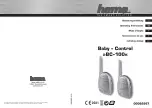
8
4.2 Plumbing
The instrument is designed to require very little head pressure to
operate, but will need around 0.34 bar (5 PSI). The maximum pressure
for proper operation should not exceed 10.3 bar (150 PSI). The
maximum allowable fluid temperature is 55°C (131°F).
NOTICE
The fluid waste from drain connection of this instrument contains
reagents with large quantities of sample water. HF scientific
recommends that operators check with local authorities
concerning proper disposal of waste diluted fluids. This waste
fluid must NEVER be reintroduced into the incoming water stream.
All plumbing connections are intended to be made through stainless
steel connections.
The water sample inlet requires 6 mm OD stainless steel tubing. The
fitting is a compression fitting so the installer need only place the
supplied the nut and feral over tubing and tighten.
The water drain requires 12 mm OD stainless steel tubing. This fitting is
also a compression fitting so the installer need only place the supplied
the nut and feral over tubing and tighten.
Properly installed and sealed connections are required to ensure the
water tightness and ratings of the instrument.
NOTICE
The drain must be open to the Atmosphere for proper operation.
4.3 Air Supply
This instrument requires water and oil free air, (-40°C [-40°F ] Dew
Point, Particles <5u, ISA Grade Hydrocarbon free). The air needs to
be provided at between 5.5 and 7 bar (80-101.5 PSI) with a volume of
35 SLPM (1.2 SCFM) as measured at 5.5 bar (80 PSI). This air supply
must be provided continuously from a known safe area.
The air connection requires 6 mm stainless steel tubing. A compression
type fitting is supplied on the base of the main enclosure that simply
requires the installer to slip the supplied nut and feral over the tubing
and then tighten the nut.
4.4 Electrical Connections
All electrical connections must pass through the three compression
grommets on the left side of the instrument. Cabling must be selected
to ensure that these connections are tight. The grommets can accept
cabling from 11 to 21 mm diameter. One grommet is supplied for
system power and two are supplied for low voltage I/O connections.
These grommets must be tightened to maintain cabinet air pressure.
The electrical power for the protective gas supply (blower, compressor,
etc.) should be either taken from a separate power source or taken
from the supply side of the electrical isolator for the pressurized
enclosure.
Most of the low voltage electrical communication connections to the
instrument are made at the termination area which is located on the
left side of the instrument. Remove the access cover by loosening the
captive screw. The connections are labeled and are self-descriptive.
Please follow all government recommendations for installation of
electrical connections to and between the instrument and other
peripheral devices.
All terminals are designed to accept wires in the range of 14-28 AWG.
All wires should be stripped to a length of 6 mm (¼").
For line power connections refer to the companion
manual Catalog No. 28749.
4.4.1 RS-485
The RS-485 half-duplex (2-wire) digital interface operates with
differential levels that are not susceptible to electrical interferences. This
is why cable lengths up to 3000 ft can be implemented. The last device
on each bus may require terminating with a 120 ohm
resistor to eliminate signal reflection on the line. Do not run
RS-485 cables in the same conduit as power. Set-up of the
RS-485 is covered in 8.3
Configuring the RS–485 Port.
To prevent damage to the instrument,
ensure that power is disconnected
prior to making connections. For ease
of connecting, remove the plug-in
terminal block. Connections are
labeled beside this termination on the
PC board. The recommended cable
is 22 AWG shielded twisted pair. The
grey terminal block is removable to
assist in making connections.
4.4.2 Relay
One relay alarm connections labeled
ALM COM & ALM NO is provided.
Please note that this is a fail-safe so
the “normal” condition is power to the
CLX-Ex on and no alarm condition.
The relay is rated 240VAC
2A. Operation of this alarm
is covered in section 8.4
Configuring the Alarm.
4.4.3 4-20 mA
The 4-20 mA output is driven by a 15 VDC power source and can drive
recorder loads up to 600 ohms. Transformer isolation is
provided on the CLX-Ex. Do not run 4-20 mA cables in the
same conduit as power. Operation of this output is covered
in section 8.1
Setting the 4-20 mA
.
To prevent damage to the instrument, and for general safety ensure
that power is disconnected to the CLX-Ex prior to making any
connections. Polarities of the connections are labeled beside this
termination on the PC board.
The recommended cable is 22 AWG shielded twisted pair. To prevent
ground loops, connect the shield at either the CLX-Ex or at its
destination, but not both. The grey terminal block is removable to assist
in making connections.
The 4-20mA is factory calibrated. An adjustment is available on the
4-20mA in sections 8.12 and 8.13. In addition to making adjustments,
these menus output continuous 4 mA or 20 mA and can be used as a
signal test. Remember that the configuration mode will timeout after
15 minutes.
4.4.4 Remote Standby Connections
The instrument operates on user control software, where an external
control initiates each cycle. This control line is called the RSI short for
Remote Standby Input.
The CLX-Ex will indicate the current status on another line called RSO
or Remote Standby Output. These connections are a relay contact that
is closed when busy and open during when in standby mode.
The connections are labeled RSI and RSO. The RSI has + and – polarity
connection associate with it and expects a 24VDC control signal.
The RSO is simply a relay contact and is not polarized.








































